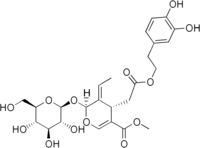Oleuropein
 | |
| Names | |
|---|---|
| IUPAC name
(4S,5E,6S)-4-[2-[2-(3,4-dihydroxyphenyl)ethoxy]-2-oxoethyl]- 5-ethylidene-6-[[(2S,3R,4S,5S,6R)-3,4,5-trihydroxy-6-(hydroxymethyl)-
2-tetrahydropyranyl]oxy]-4H-pyran-3-carboxylic acid, methyl ester | |
| Identifiers | |
| 32619-42-4 | |
| 3D model (Jmol) | Interactive image |
| ChEMBL | ChEMBL1911053 |
| ChemSpider | 4444876 |
| ECHA InfoCard | 100.046.466 |
| PubChem | 5281544 |
| |
| |
| Properties | |
| C25H32O13 | |
| Molar mass | 540.51 g/mol |
| Except where otherwise noted, data are given for materials in their standard state (at 25 °C [77 °F], 100 kPa). | |
| | |
| Infobox references | |
Oleuropein is a phenylethanoid, a type of phenolic compound found in olive leaf together with other closely related compounds such as 10-hydroxyoleuropein, ligstroside, and 10-hydroxyligstroside. All these compounds are tyrosol esters of elenolic acid that are further hydroxylated and glycosylated. It is one of the main natural phenols found in argan oil.[1] It is also found in the leaves of privet.
Pharmacological properties
In preliminary laboratory research, oleuropein had activity as an agonist of the G-protein estrogen receptor.[2]
Oleuropein inhibited the enzymatic activity of mammalian target of rapamycin (mTOR) with an IC50 value of 905 nM, suggesting that mTOR inhibition is at least one of the reasons for the reported anti-cancer properties of oleuropein.[3]
Other basic research is examining whether oleuropein has pharmacological properties.[4] More research is needed to determine if these effects exist in humans.
Oleuropein is traditionally removed from olives due to its bitterness.
See also
References
- ↑ Phenols and Polyphenols from Argania spinosa. Z. Charrouf and D. Guillaume, American Journal of Food Technology, 2007, 2, pages 679-683, doi:10.3923/ajft.2007.679.683
- ↑ Prossnitz, Eric R.; Barton, Matthias (2014). "Estrogen biology: New insights into GPER function and clinical opportunities". Molecular and Cellular Endocrinology. 389 (1-2): 71–83. doi:10.1016/j.mce.2014.02.002. ISSN 0303-7207.
- ↑ Taha, Mutasem O.; Khanfar, Mohammad A. (2014-07-20). "Oleuropein potently inhibits mammalian target of rapamycin: possible involvement of tandem anomeric hyperconjugation–Michael reaction". Medicinal Chemistry Research. 24 (2): 616–623. doi:10.1007/s00044-014-1168-9. ISSN 1054-2523.
- ↑ Haris Omar, Syed (2010). "Oleuropein in Olive and its Pharmacological Effects". Scientia Pharmaceutica. 78 (2): 133–54. doi:10.3797/scipharm.0912-18. PMC 3002804
 . PMID 21179340.
. PMID 21179340.